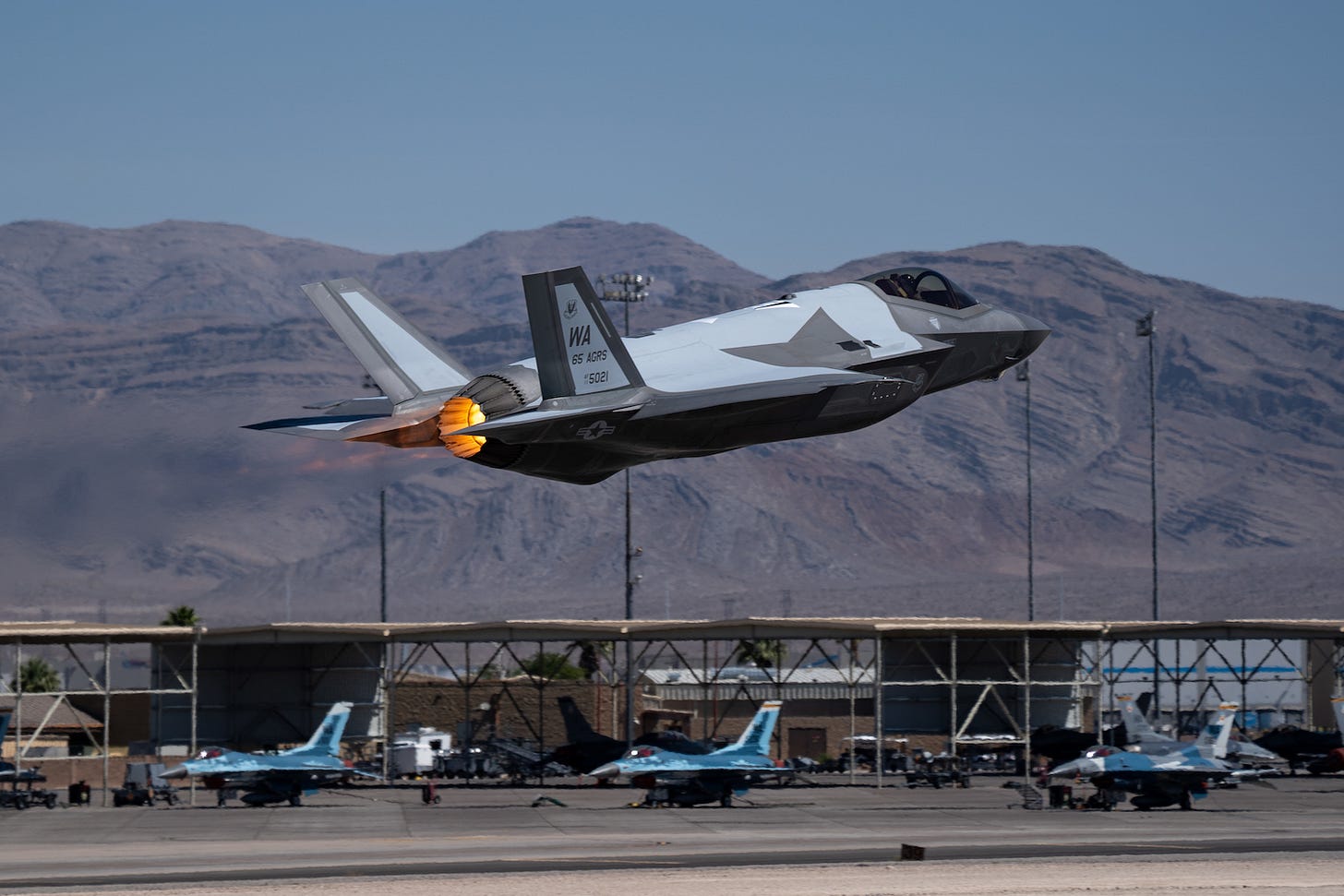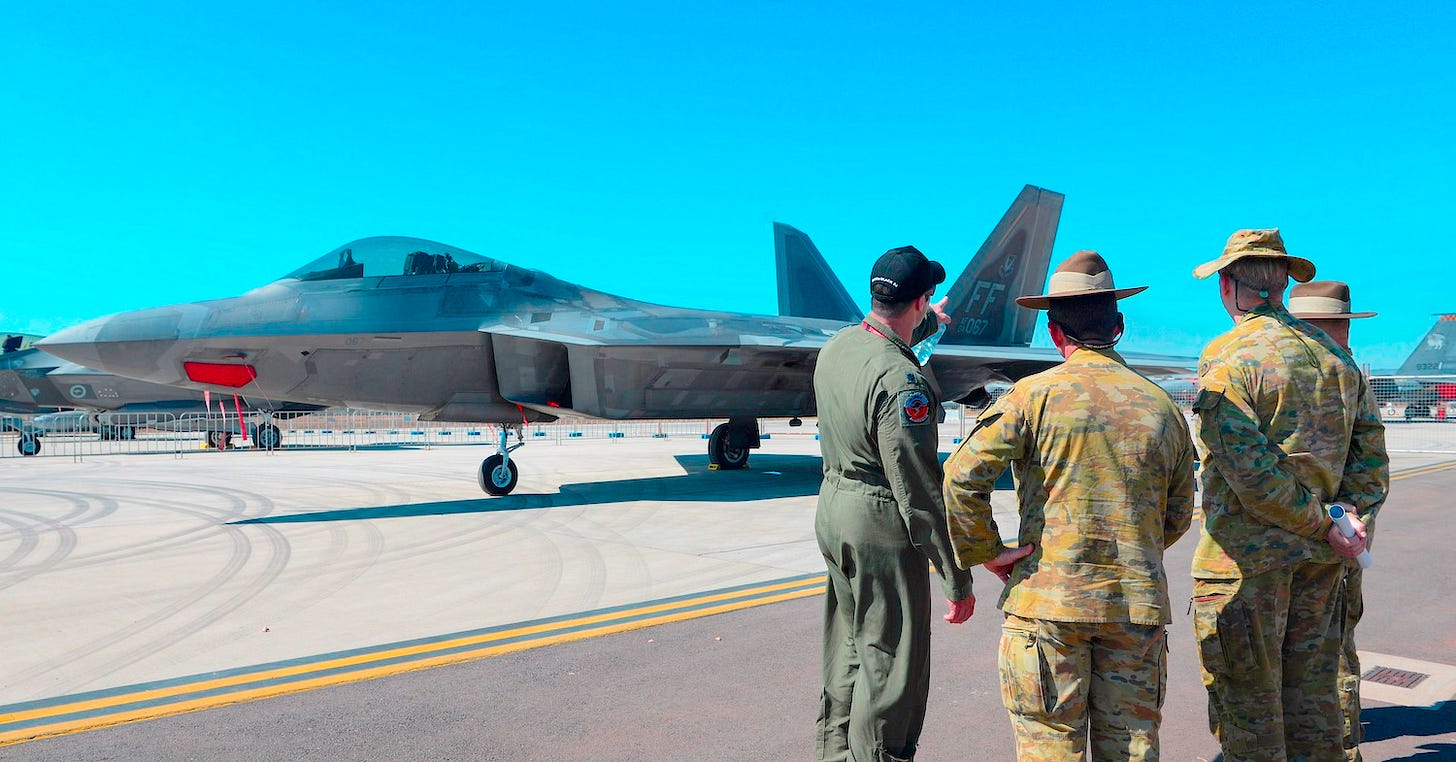The US Air Force is scouting rival jets and friendly bases to prep for a clash with China
US Pacific Air Forces is using its "robust exercise program" to replicate new threats and evaluate new operating locations.
BANGKOK — Across the Pacific, the US Air Force is stepping up its preparations for a potential clash with China by expanding its training to replicate new threats and engaging with more countries in hopes of gaining access to new bases.
Bigger, more complex drills and increased outreach both reflect US commanders’ belief that to counter China’s increasingly capable military, they’ll need more friends and more places to operate from.
The Air Force has been intensifying its exercises for several years, adding higher-end drills to prepare pilots for a rival that can compete for control of the air, a challenge they’ve rarely faced since the Korean War. In the Pacific, new exercises are being held and existing exercises are growing.
A common component of recent training is “agile combat employment,” a concept in which airmen will dodge Chinese attacks by moving between a few developed “hub” bases and remote, austere “spoke” bases.

The bigger-is-better approach was on display last year in major exercises that grew to record size or spread to new locations. The trend has continued this year. In July alone, US aircraft participated in two major exercises on opposite sides of the Pacific.
Early in the month, the German, French, and Spanish air forces for the first time joined US and Canadian forces in Alaska for Arctic Defender. The exercise included German and Spanish Eurofighter Typhoons training with US fifth-generation, or stealth, jets and was meant “to push everyone's limits with a high-flying exercise involving complex scenarios,” a French air officer said.
Later in the month, those European air forces joined 17 others in Australia for Pitch Black, which was the largest edition in the exercise's 43-year history. It also had the most stealth jets in the exercise’s history, with US F-22s, which participated for the first time, squaring off against Italian and Australian F-35s and other jets across the sprawling airspace and far-flung bases of northern Australia. F-22s were an important addition because it’s “the first fifth-generation fighter,” an F-22 pilot said. “We have unique capabilities that the F-35s and other platforms don’t have.”
Incorporating European allies and other partners allows for bigger exercises and for more “threat replication” by giving pilots a chance “to see and to deal with platforms and things that we may not normally deal with out there,” Gen. Kevin Schneider, the commander of US Pacific Air Forces, or PACAF, told me in an interview in July.

Threat replication has become a bigger concern as rivals field more advanced jets, like China’s J-20, which isn’t on par with US stealth jets but is seen as good enough for what Beijing wants to do in the Western Pacific. The US Air Force has set up an “aggressor” squadron with F-35s to act as adversaries in exercises and is training more with allies, including Japan and Australia, who field their own F-35s.
The “proliferation” of stealth jets among allies and partners means “now we can use fifth generation for 'red air' threat replication to be a little bit more indicative of what we're seeing either out of the PLA or Russian forces,” Schneider said, referring to China’s People’s Liberation Army.
Schneider’s deputy, Lt. Gen. Laura Lenderman, said this month that PACAF will pull many of its operating concepts together in an even larger exercise next summer. Resolute Force Pacific will involve nearly 300 aircraft — double the 140 at Pitch Black — operating from 25 locations across the region in “a full-scale large-force exercise.”
The goal, Lenderman said, is “to integrate and experiment with logistics, sustainment, and enabling capabilities to bring fifth-gen fighters, command-and-control aircraft, and airlift and air-refueling into the Western Pacific at speed and scale.”
‘Hearts-and-minds campaign’
As PACAF has expanded its exercises, it has also been searching for new bases. Airmen have scoured the Pacific to find airfields that can be restored to support modern aircraft. They’ve zeroed in on a number of facilities that US forces already have access to but which have been largely unused since World War II.
“I like to say very frequently, like, we’re going back to the future,” Lt. Col. Frank Blaz, a PACAF logistics and engineering officer, said in an Air Force video published this month.
On Guam, a US territory that hosts major military bases, airmen are rehabilitating runways at Northwest Field, which was deactivated in 1949. About 100 miles to the north, two WWII-era airfields on Tinian, another US territory, are being refurbished with new pavement, fuel pipelines, and other equipment. Several hundred miles to the west, Marines have recertified a WWII-era airfield in Palau, which is aligned with Washington through a Compact of Free Association. Nearby, in the Federated States of Micronesia, another COFA state, the Air Force wants to spend $400 million to upgrade Yap International Airport, according to the service’s 2025 budget proposal.
As a part of agile combat employment, “we have taken a look at all of the historic airfields within the Pacific that helped to launch and execute successful campaigns,” Blaz said. “Building new is not the way to go, and it’s very expensive. Repair and rehabilitating what exists is a much better economic solution.”
PACAF has also used its “robust exercise program” to scope out facilities in other countries, according to Michael Winkler, the command’s deputy director for air and cyberspace operations.
PACAF holds about 30 exercises a year, which “run the gamut from multilateral exercises with many partners to bilateral exercises with a single ally or partner, usually in their territory, usually executed at a base that we may be interested in getting access to so we can kind of use those as an operational evaluation of that airfield,” Winkler, a retired Air Force general, said on a podcast this summer.
US stealth jets appear to have led the way for some of those assessments. F-22s have made first-time visits to the Philippines over the past two years, including to Basa Air Base, where the Pentagon is funding upgrades to support operations by US aircraft. (The US is funding similar work at bases in northern Australia.) US stealth jets have also made milestone tours of Southeast Asia twice this year, with F-35s making first-time visits to Brunei, Singapore, and Thailand in March and F-22s making first-time visits to Indonesia and Brunei and a stop in the Philippines in August.
Such visits are part of PACAF’s pursuit of what Winkler called “interoperability, access, basing, and overflight” with countries in the region. Many countries are now more interested in that kind of engagement because of concerns about China’s aggressive activity, which is “opening doors for us,” Schneider said in July.
When airmen deploy to those countries, one of their tasks is keeping those doors open.
“In conjunction with those exercises,” Winkler said, “a lot of times we'll go out and do a public-works project on the weekend or the no-fly days” as part of “a hearts-and-minds campaign or showing some goodwill to those countries.”
Those are "low-level efforts,” Winkler added, but “the theory is that maybe that springboards into some public sentiment that will allow us to get access to some of those locations in the future.”






